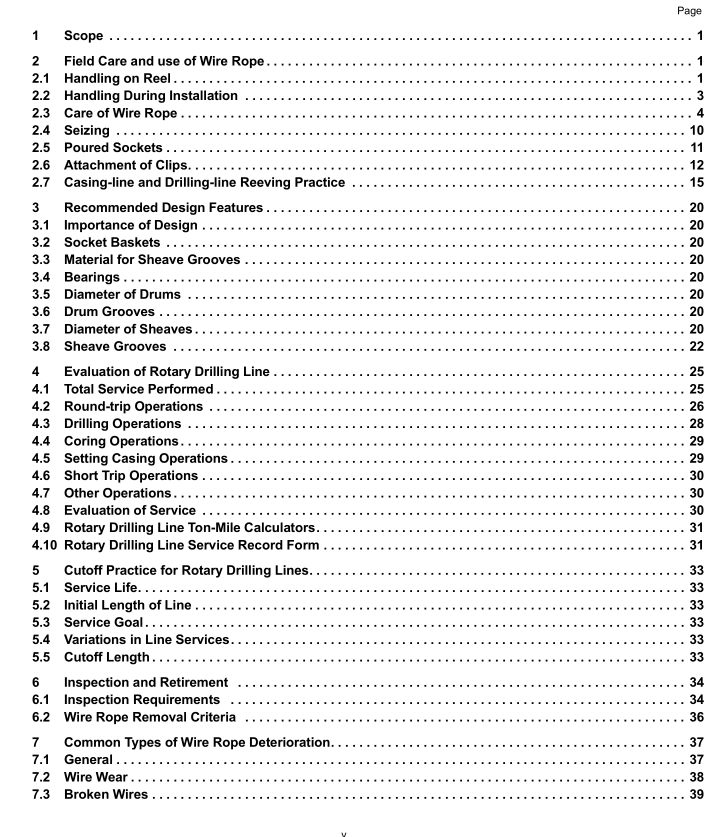API RP 9B pdf download

API RP 9B pdf download Application, Care, and Use of Wire Rope for Oil Field Service
1 Scope
This recommended practice (RP) covers typical wire rope applications for the oil and gas industry.
Typical practices in the application of wire rope to oil field service are indicated in Table 1, which shows the sizes andconstructions commonly used.Because of the variety of equipment designs, the selection of constructions other thanthose shown is justifiable.
In oilfield service,wire rope is often referred to as wire line or cable. For the purpose of clarity, these variousexpressions are incorporated in this recommended practice.
2Field Care and use of Wire Rope
2.1Handling on Reel
2.1.1 Use of Binding or Lifting Chain
When handling wire rope on a reel with a binding or liting chain, wooden blocks should always be used between therope and the chain to prevent damage to the wire or distortion of the strands in the rope.
2.1.2 Use of Bars
Bars for moving the reel should be used against the reel flange, and not against the rope.2.1.3 Sharp Objects
The reel should not be rolled over or dropped on any hard, sharp object in such a manner that the rope will bedamaged.
2.1.4Dropping
The reel should not be dropped.This may cause damage to the rope as well as break the reel.2.1.5 Mud,Dirt, or Cinders
Rolling the reel in or allowing it to stand in any medium harmful to steel such as mud, dirt, or cinders should beavoided. Planking or cribbing will be of assistance in handling the reel as well as in protecting the rope againstdamage.
2.1.6 Lifting the Reel
The preferred method for lifting a reel with slings is to use a spreader bar that is of sufficient length to keep the slinglegs from contacting the reel.This will prevent the flanges of the reel from being bent, distorted, broken, or damagedin any way by the slings.
2.1.7Shaft through Arbor Holes
When lifting reels of wire rope, care must be taken that the shaft through the reel is of adequate length for the task,plus its wall thickness and diameter are of sufficient strength and size respectively to safely support the weight withoutdamaging the center holes of the two flanges of the reel.
2.2Handling During Installation2.2.1 Stringing of Blocks
Blocks should be strung to give a minimum of wear against the sides of sheave grooves.2.2.2Changing Lines and Cutoff
lt is good practice in changing lines to suspend the traveling block from the crown on a single line.This tends to limitthe amount of rubbing on guards or spacers, as well as chances for kinks. This practice is also very effective in pull-through and cut-off procedure.
2.2.3 Rotation of Reel
The reel should be set up on a substantial horizontal axis so that it is free to rotate as the rope is pulled off,and insuch a position that the rope will not rub against derrick members or other obstructions while being pulled over thecrown.A snatch block with a suitable size sheave should be used to hold the rope away from such obstructions.
2.2.4Jacking
The use of a suitable apparatus for jacking the reel off the floor and holding it so that it can turn on its axis is desirable.2.2.5 Tension on Rope
For proper spooling, new ropes shall be installed under tension. This will reduce rope crushing and, if the tension issufficient, prevent the “pulling-inof upper layers in multiple layer spooling.
2.2.6 Twist in Rope
When installing a new rope, it is important that twist or torque not be in the installed rope. if twist or torque is apparent.the twist should be removed before the rope is anchored.
2.2.7Kinking
Care should be taken to avoid kinking a wire rope since a kink is cause for removal of the wire rope or damagedsection.
2.2.8Striking with Hammer
Wire ropes should not be struck with any object such as a steel hammer, derrick hatchet, or crow bar which maycause wire displacement and distortion.Even when a soft metal hammer is used, it should be noted that a rope canbe damaged by such blows. Therefore, when it is necessary to crowd wraps together, any such operation should beperformed with the greatest of care; and a block of wood should be interposed between the hammer and rope.
2.2.9 Cleaning
The use of solvent may be detrimental to a wire rope. f a rope becomes covered with dirt or grit,it should be cleanedwith a brush and followed by appropriate lubrication as necessary.
2.2.10 Excess or Dead Wraps
After properly securing the wire rope in the drum socket, the number of excess or dead wraps or turns specified by theequipment manufacturer should be maintained.For rigs with motion compensating equipment, enough additionalrope shall be spooled on the drum to maintain the minimum number of dead wraps when the rope required by thecompensator is at its maximum.









